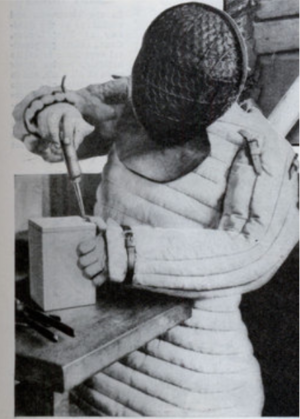No comment.
No comment.
Further to my earlier post about German booby-traps on the battlefield in 1918 and the similarities to today’s IED threat, I’ve found the following typed document, a briefing paper, of sorts, from the office of the Chief Engineer of the General Headquarters of the American Expeditionary Forces in France in 1918. The document is titled “GERMAN TRAPS AND MINES” and describes the booby traps being encountered by American forces as the Germans retreated. Those of you with recent experience in Iraq and Afghanistan will recognise some of the phrases.
The document is a little faded, but I’ll make it as big as possible. It’s worth reading.
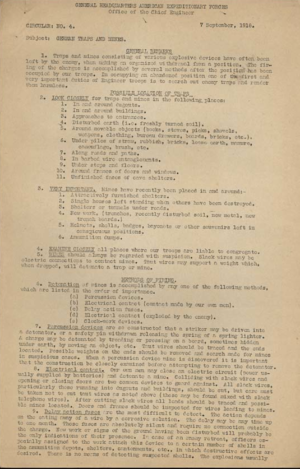
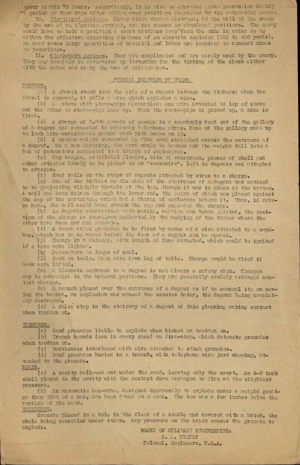
Readers may recall that I have blogged before about German IEDs and sabotage devices in the US during the period 1915- 1918, focused on munitions plants and shipping on the US East Coast. I’ve been doing some more research on German IEDs of the period in general and found a remarkable number in Europe right towards the end of the war. A significant number were being left behind when the German army retreated in 1918 and others were being transported from Germany via Norway and Switzerland Some of the IEDs were sophisticated and used some dastardly (love that word) initiation systems. Here’s some examples:
In October 1918, because so many “infernal machines” had been found, US forces adopted a strict policy of clearance of facilities vacated by retreating Germans. Therefore they must have by implication had a significant search and EOD capability. US forces discovered a temperature initiated IED in one dug out left behind by retreating Germans. US ordnance specialists defused the device and assessed that since there were no houses in the area, the Germans expected the advancing Americans to occupy the dug out , and that when they warmed up the space, the switch would have initiated the device. In the dug out they found the temperature switch under a “cot”, with ten large artillery shells buried nearby connected to the switch. On at least one occasion a device left in a bed in a house vacated by German troops detonated killing an allied soldier who lay on it. There are reports of a booby trapped pair of binoculars. As one quote of the time said

There are unsubstantiated reports that the Germans realized how popular their spiked helmets (pickelhaube) were and so frequently booby trapped them.
Another report (written by Col Joseph Hyde of the US 105th Engineers) reported a 300 pound device in a church steeple, connected to a pressure plate where a man might kneel in front of the altar.
In April 1918 , Norwegian authorities discovered one hundred and seven IEDs that had been smuggled into Norway by German agents, with a view to attacking Norwegian shipping. Also recovered were:
104 incendiaries
9 IEDs disguised as lumps of coal
133”strikers”
269 detonators
470 tubes of acid (for delay fusing)
33 pieces of explosives disguised as chewing tobacco
some fountain pens filled with acid as delay initiators
95 large rectangular bombs in iron cases, initiated with a clockwork mechanism
Also in 1918, Swiss authorities discovered a similar plot, which involved German diplomats smuggling sabotage devices and explosives through Switzerland and on to Italy. In a similar manner to the way in which IEDs were manufactured in the US, so the Germans established two bomb making facilities in Switzerland at this time.
Here’s a couple of press clips about the devices, one in a piano in 1916 and one from 1918.
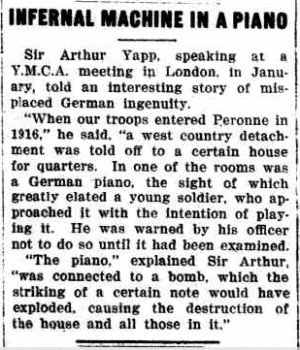
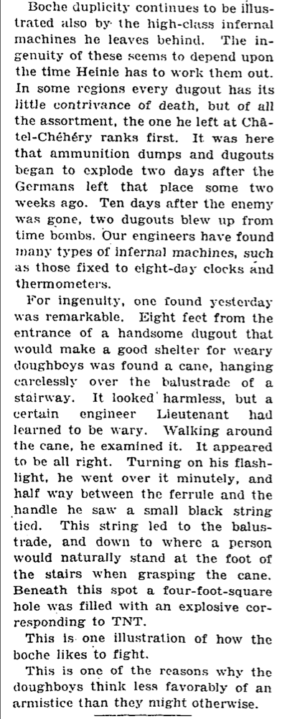
I have found some interesting official US Army documents detailing how common booby traps and other IEDs were towards the end of WW1 – they bear remarkable resemblance to documents detailing the threat in Afghanistan today – I’ll post them in a few days time.
Hitler was the subject of a number of assassination attempts. This is the story one of the lesser known ones, using an IED.
Georg Elser was an ordinary German carpenter who took a dislike to Hitler in the 1930s. In late 1938 Elser decided to assassinate Hitler. He took this decision apparently as an individual, with no outside help. He became aware that once a year Hitler returned to Munich to give a speech in a famous Munich Beer Cellar. He visited the cellar in November 1938 and decided it would be the site of an attack a year later, showing immense patience and careful planning. Not having access to explosives but realising that an IED would be suited to the attack, Elser got a job in a quarry and over the year was able to steal enough explosive components. He made several “test” devices and exploded them successfully in the Bavarian countryside.
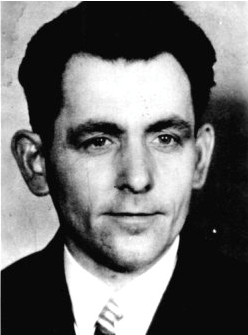
Several weeks before the planned assassination, Elsner frequented the Beer cellar and each night hid in a storeroom before closing time. Then after everyone had left, he spent the night preparing the location for his concealed IED. He removed a wooden panel and hid the explosives in a space he chipped out methodically from a stone pillar adjacent to where Hitler was due to speak. The preparation took two months, working almost every night.
Finally Elser placed the charge, which he had built into a cork lined wooden box, to conceal the noise of the ticking clock timer. He set the timer to go off at 9.20pm on 8 November 1939, twenty minutes into Hitler’s scheduled hour long speech. The IED functioned right on time, right as expected, killing eight and wounding dozens more. The only problem was that Hitler had rescheduled the time, had spoken at 8pm and was out of the building at 9.07pm, to catch a train.
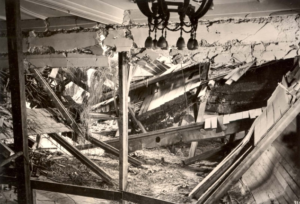
Elsner was caught trying to cross the border into Switzerland and arrested. The border police then found a postcard of the beer cellar in his pocket along with a diagram of an IED. The game was up. Elsner confessed all. He was imprisoned and eventually killed in Dachau concentration camp.
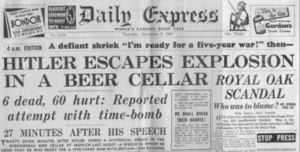
There were other attempts to kill Hitler with explosives, including the von Stauffenberg plot, and other failed plots, one involving a suicide IED hidden in the operatives trousers…(underpants bombers aren’t new!) and one hidden in a bottle of Cointreau – I’ll save those stories for future blog posts.
This attack was interesting – by being able to (almost) predict a year in advance the presence of his target Elser was able to conceal an IED behind wooden panelling and time the device to explode at the right time – exactly the same technique used in the failed attempt to assassinate Margaret Thatcher with a timed device hidden behind panelling in the Brighton Hotel in 1984.
